
Guest Blogged by Mewa Singh
Fresno is home to one of the United States’ larger Sikh populations and the Fresno Bee is often the battleground for local Sikhs. Articles on Sikhs appear rather frequently so it is no surprise that this weekend had another (thanks Sundari).
The article details the life of a Gurdeep Sihota. Transparency in The Langar Hall calls for me to acknowledge that I have known Gurdeep for many years and she truly is a wonderful and remarkable woman. Most Sikh students at Fresno City College know Gurdeep’s bright smile. The article states what many know: she goes out of her way for her students, even opening her home as a safe haven for those in need.
While some Langar-ites may focus on her personal life and decisions, I was hoping we could move this in another direction and spark a conversation on issues of the American media and even reflections within our Sikh community.
First off, I (and Gurdeep through a personal correspondence) have problems with the title. Gurdeep has found her spiritual peace choosing another path. Then why in the article still label her a Sikh? The story occurs often enough where a woman (or man) chooses to go against the status quo and create a life that is best for them. The individual is lauded for their bravery. However, should the rest of the community be demonized? In the article, Gurdeep’s father encouraged her to pursue her degree, saying, “Education is more important than anything.” Things may not have turned out how her father may have planned, but his love for his daughter in the article is still apparent:
Her father said he’s proud of Sihota, but he wishes he saw her more often. “She comes once in a while, but mostly I call,” he said.
Still why through the title and through the general tone does the American media love to laud itself by pushing against others’ cultures and traditions? Are other cultures really like the ‘Mafia’?
My other question actually refers to the future in our community. While our parents’ generation may not be able to accept those that go against the status-quo (e.g. older unmarried men and women), is there still a place for these people within our community? Will our generation have less of a problem? At this point, unfortunately, I don’t see positive signs in this direction. Will members of our community be shunned and be forced out if they don’t fulfill what are considered ‘norms?’ Does the stigma fall more on women than men? How large is the embrace of our arms?
 This morning 1500 prisoners in a Jalandhar jail rebelled due to the attack by prison guards on the Sikh religious icons. Initial reports seem to indicate that the guards forcibly cut the hair of the Sikh inmate and others had prisoners had been pressured to cut their hair as well. The acting superintendent alleges that the cutting of the hair was a ‘concocted’ story, but widespread abuse by the Punjab Police seems to give little credence to his comments. Such rebellions were common during the British Raj and it seems the zulm (injustice) continues.
This morning 1500 prisoners in a Jalandhar jail rebelled due to the attack by prison guards on the Sikh religious icons. Initial reports seem to indicate that the guards forcibly cut the hair of the Sikh inmate and others had prisoners had been pressured to cut their hair as well. The acting superintendent alleges that the cutting of the hair was a ‘concocted’ story, but widespread abuse by the Punjab Police seems to give little credence to his comments. Such rebellions were common during the British Raj and it seems the zulm (injustice) continues.
The rebellion became violent as maltreatment, lack of justice, and deteriorating medical and food provisions had been grievances. BBC News has reported on the story and more reports seem to filtering in. More updates soon.
This article didn’t sit well with me. While the author tries to maintain some sort of ‘objective’ tone to voice the ‘ambiguities,’ it all read as a surreal story of perverted neo-colonialism and dominant commodification.
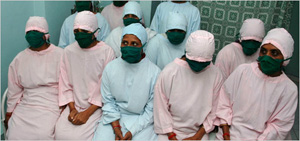 The NY Times author writes about the spread of a ‘surrogate mother industry’ in India. Whereas surrogacy in America can cost upwards to $80,000, globalized outsourcing cuts the cost to a mere $5000 in India. This fast-growing $445-million-a-year business is extremely lucrative. However, I can’t understand the ethics.
The NY Times author writes about the spread of a ‘surrogate mother industry’ in India. Whereas surrogacy in America can cost upwards to $80,000, globalized outsourcing cuts the cost to a mere $5000 in India. This fast-growing $445-million-a-year business is extremely lucrative. However, I can’t understand the ethics.
Listening to the NPR piece, the sense of entitlement the American “Julie” borders on the absurd. She languishes that American surrogates may be “smoking, drinking alcohol, doing drugs…no one policing her in the sense that you don’t know what’s going on.” For “Julie” she prefers India where surrogate women are ‘stored’ in a “clinic or one of the supervised homes, making it easier to monitor diet and health. This kind of control just wouldn’t be possible in the States, says Julie.”
The author believes that leasing wombs can be ‘empowering.’ For individual women this may be the case when faced with abject poverty. India’s poverty is brutal. Thus I pass no judgment on the poor rural women. However I MUST condemn the institutional hierarchies and poverty that makes such global inequality possible. For me, there can be no hesitancy or ‘ambiguity.’ Such practices occur because of the conditions that make people sell their kidneys in India. This only furthers the problem of ‘commodification’ of women in that their womb is nothing more than a ‘money-maker.’ Does this lead to greater violence towards women? The effects of the commodification of women have already been discussed on this young blog. Global inequality must be condemned in the strongest terms. There is no moral relativism. Where there is such disparate global inequality, we have global injustice.
Recently I have read a few articles about instances where Sikh leaders have partaken in activities with various anti-Sikh groups, such as the RSS and Dera Sacha Sauda.
In part, the controversies that have arisen are rooted in the questions of what role Sikh leader ought to play in the context of anti-Sikh propaganda. Should our leaders be attending functions organized by anti-Sikh groups? Should they boycott them? Many leaders have been seen “supporting” such organizations by hobnobbing with, accepting gifts from, and turning a blind eye to their activities.
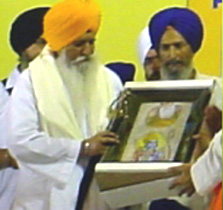
One recent instance of this is the Jathedar of the Akal Takht and others accepting pictures which expressly co-mingle Sikhi with Hinduism (with Guru Nanak Dev Ji and Sri Ram) at an RSS function. It may not seem like a big deal, but one of the RSS’s assertions is that Sikhs are derivatives of Hinduism and that the Guru’s are the descendants of the Hindu God Ram. I wonder if anyone else feels that our Jathedar’s acceptance of such a picture is a bit shady? As a Sikh I expect my leaders to stand up for Sikh beliefs and the Sikh identity – not accept memorabilia which dilutes my identity and depicts something that they sit on stages across the globe and negate.
As I write this post, I realize that some of you may be thinking that of the instance above does not amount to much, but I think it is illustrative of a much larger issue …if our leaders do not take a stand on something as simple as “Sikhi and Hinduism are not the same,” then where does that leave us as a Sikh nation? How are we to face other challenges to our identity in the West? What are our expectations of our leaders? And are there any avenues we can take to enact change?
Veerharinder Singh and Pawanjot Kaur were married on November 1, 2001. Apparently this ill-fated relationship started off on the wrong foot.
Veerharinder had said he was a graduate owning gas stations. He turned out to be class 12 pass and an employee in a factory. Pawanjot was B.Sc medical.
Veerharinder then left for Surrey, abandoning his bride in Punjab.
Ranphool (Pawanjot’s father) claimed the man and his family were all good till they gave wrong information to the embassy that had rejected the papers of my daughter to emigrate to Canada.
As if abandoning the bride wasn’t enough: Veerharinder demanded 30 lakh (a mere $75,000!) for dowry, and his father was camped out in Punjab, waiting to receive this from Pawanjot’s family.
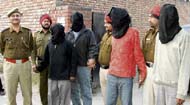 Pawanjot came to Canada on her own and stayed with her grandfather in Edmonton when Veerinder’s family rejected her. Then, the plot thickens… Veerharinder tried to teach his father-in-law a lesson for sending Pawanjot to Canada.
Pawanjot came to Canada on her own and stayed with her grandfather in Edmonton when Veerinder’s family rejected her. Then, the plot thickens… Veerharinder tried to teach his father-in-law a lesson for sending Pawanjot to Canada.
Police charges allege that the husband and his cousin hired a group of contract killers for 120,000 rupees (about $3,000) after the father of the bride could not raise the dowry for his daughter.
Luckily the killers were amateurs discussing their plan at a dhaba … where they were overheard and reported to the police.
Veerharinder, how do you face yourself in the mirror?
Although this blog is new, I couldn’t resist getting the in the ‘countdown’ spirit with another useless list. Oh well, the end of the calendar year (although not the Nanakshahi Sikh calendar) gives us some time for thoughts and reflections. Here is my list of this year’s top 5 events that will influence 2008 and beyond.
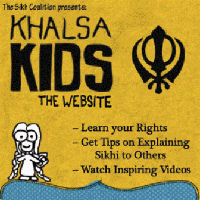 5. Khalsa Kids – The Sikh diaspora is coming of age and creating new tools for the community. It has been over ten years since the suicide of 13 year old Vijay Singh in the UK after being repeatedly bullied in school. Unfortunately the bullying of young Sikh boys tends to be the rule and not the exception. The Sikh Coalition released a harrowing report that showed 77.5% of Sikh boys surveyed in Queens reported being teased or harassed on account of their Sikh identity. However, the community is beginning to respond and it reveals a coming of age here in the US Sikh population.
5. Khalsa Kids – The Sikh diaspora is coming of age and creating new tools for the community. It has been over ten years since the suicide of 13 year old Vijay Singh in the UK after being repeatedly bullied in school. Unfortunately the bullying of young Sikh boys tends to be the rule and not the exception. The Sikh Coalition released a harrowing report that showed 77.5% of Sikh boys surveyed in Queens reported being teased or harassed on account of their Sikh identity. However, the community is beginning to respond and it reveals a coming of age here in the US Sikh population.
A Sikh teacher, SriNam Singh Khalsa, recently published Break the Bully Cycle: Intervention Techniques and Activities to Create a Respectful School Community. This book provides strategies to enable school teachers and administrators in helping not only the victims of bullies, but also the bullies themselves. Another book, written by a Sikh high school student, Harkirat Singh Hansra, helps to give non-Sikhs, especially students, a basic understanding on Sikhi. Titled Liberty at Stake – Sikhs: The Most Visible Yet Understood Minority in America provides a Sikh teenager’s perspective of the world around him. Finally, perhaps the most innovative project was the Sikh Coalition’s launch of its Khalsa Kids website. Fun, interactive, and professional the Sikh Coalition must be commended for creating a real tool that will serve Sikh communities throughout the world. That the Sikh community has a multi-faceted approach and is using its resources is a great success of 2007 that will set the bar for 2008 and beyond.
 As we celebrate the New Year and look forward to what it holds in store for us (at the very least an election!), it is important to look back and remember what we have experienced as a community this past year. In celebration of the Sikh Diaspora and what it represents to us today, here is a look back at some of the global stories, books, films and websites that impacted our community in 2007.
As we celebrate the New Year and look forward to what it holds in store for us (at the very least an election!), it is important to look back and remember what we have experienced as a community this past year. In celebration of the Sikh Diaspora and what it represents to us today, here is a look back at some of the global stories, books, films and websites that impacted our community in 2007.
- Young Sikh Men Get Haircuts, Annoying Their Elders. “It’s usually college-going students who are more worried about looking good than about their spiritual identity…[It] releases a certain amount of pressure.”
- A new website, Sikh Chic, discussing articles related to the art and culture of the Sikh Diaspora was launched. “We need to re-think the Sikh idea in the North American idiom, in our language, in our way of articulating our thoughts.”
- The Sikh clergy issues an edict directing the Sikh Sangat to snap all ties, including social, religious and political, with Baba Ram Rahim Gurmit, head, Dera Sacha Sauda, and its followers.
- Several books for and about Sikhs are published and discussed including Shame, Sacred Games, Sikhs in Britain, Londonstani, Sikhs Unlimited, I See No Stranger: Early Sikh Art and Devotion.
- A Sikh-Canadian group slams the long-standing immigration policy that forces people with the surname Singh or Kaur to change their last names. It was later noted that the immigration letter sent out was poorly worded.
Yesterday, we received a special request for a blog topic. The urgency and pain expressed in the comment inspired me to write.
 In 2006, the Jakara Movement sponsored an online survey that revealed a horrifying 1 in 4 women that took the survey revealed that they had been the victim of sexual abuse, while over half of the Sikh women responded that they know someone who had been abused. The results only confirm what many of us in the community already know.
In 2006, the Jakara Movement sponsored an online survey that revealed a horrifying 1 in 4 women that took the survey revealed that they had been the victim of sexual abuse, while over half of the Sikh women responded that they know someone who had been abused. The results only confirm what many of us in the community already know.
The commenter specifically asked for us to look at how authority and hierarchies create an environment for such things to occur. Press reports of Gurdwara gianis that abuse their position are not hard to find, while those of Dera Babas, whether Dera Sacha Sauda, Nanaksar, Daljit Singh of Chicago, Mann Singh Pehowa or Sai Baba are even more common. (We will leave aside the problems of ALL Dera Babas for another post).
None should ever excuse such behavior nor try to hide it. If an allegation is made, a full inquiry should be made with the burden of proof on the accused. I do believe that this allegation is the one exception where the burden should be on the accused rather than the one making the allegations. (Unfortunately, many members of our community abuse the justice system by also alleging false cases due to personal dispute and rivalries.) Many with authority feel a sense of ‘invincibility’ that stems from their ego (haumai). The victims (both females and yes, even males) are silenced and their enforced silence deafens the entire community. We need to find a community solution to the problem.
How do you know you’ve made it as a notable community? When Jeopardy! gives you your own category of clues… twice! That’s right, two nights ago my favorite game show featured the category “Punjab.” Because I can only remember three clues, those are the ones I’ll share:
 100: After 1947, the territory known as the Punjab was divided between India and this country.
100: After 1947, the territory known as the Punjab was divided between India and this country.
400: This power fought two wars, unsuccessfully, before finally annexing the territory outright in the 1800s.
500: With origins in both Hinduism and Islam, this is the region’s major religion.
Now I’ll be honest, the last clue kind of had me cheesed (although, how nice is it that Sikhi is the “MVP” of the category?). This is one of the most misquoted “facts” that circulates regarding the origins of the Sikh religion — that it is somehow a hybridization of Hinduism and Islam. It’s certainly true that Sikhi developed in the context of at least two major religions, but many argue that it is somehow an extenuation or “compromise” of the two. So, at what level do we nitpick about the terminology used to describe the faith?
That said, there is a universality of messages across faiths. Both Hinduism and Sikhi discuss the value of “seva,” and both believe (broadly) in reincarnation. Meanwhile, Islam and Sikhi both conceptualize the writing of their scriptures as divine revelation, and both are monotheistic (and describe Allah, or Vaheguru, in similar terms). Like Buddhism, there is a belief that one must learn to free herself from the trappings of the material world, and like Christianity, there is a larger message of humanism and love for mankind. Is it really fair, then, to limit Sikhi’s philosophy to a “religion with its origins in Hinduism and Islam”? And, given Sikhi’s egalitarian acceptance of and respect for other faith traditions (or non-existence thereof), is such a battle on phrasing “worth it”?
I’m a bit of a stickler for language. While I’m not the most articulate person, I do feel that framing and terminology have power. I think it’s important to offer a coherent narrative that explains the difference between Sikhi and other faiths while making it clear that a delineation is not a derogation. There is nothing shameful in distinguishing Sikhi from other faith traditions; in this case, it’s an issue of accuracy and understanding.
A couple of months ago, maybe it was many weeks, I saw on the TV show, “Cops” with utter disgust a Bapuji and Biji, being a form of “entertainment” for a domestic violence assault. Along with my disgust, anger, and sorrow I had a “well yea it happens … you think it’s that shocking” attitude. I wasn’t “shaken” or “shocked” by the show because I knew this story was a reflection of what happens in many Punjabi Sikh homes in  thing again … what if Bibiji needs to leave him, permanently or just for a while, but has no family in the United States are close to the Central Valley where she may be working… where will she go? Plus, just the utter embarrassment she may feel because in their “budhaphaa” (i.e. older age) they are still facing this issue and she has to ask for help.
thing again … what if Bibiji needs to leave him, permanently or just for a while, but has no family in the United States are close to the Central Valley where she may be working… where will she go? Plus, just the utter embarrassment she may feel because in their “budhaphaa” (i.e. older age) they are still facing this issue and she has to ask for help.
I’m wondering what anti-domestic violence advocacy campaigns and shelters are doing to address the issues faced by elderly women. The advocacy and services they offer save lives and offer hope to help women escape a cycle of violence. It think they tend to be geared more towards meeting the needs of younger women and their children. They may not explicitly state that or have policies restricting elderly women from receiving their much-needed services, but I have a feeling younger women frequent them more often not because more younger women may face the issue of domestic violence or live in the Diaspora. I think it’s because elderly women may just be more hesitant to reach out for their services at their age. I wonder what services these women’s organizations have to meet the needs of elderly South Asian, specifically Punjabi Sikh, women who are primarily of immigrant background? The circumstances of elderly Punjabi Sikh women are similar but also very different compared to those who are younger. Factors leading to these differences range from length of marriage to having grandchildren as well as son and daughter-in-laws. The reasons and circumstances for immigration may be different as well. Some elderly couples immigrate, at times, to help build an economic base and
Any ideas about domestic abuse in South Asian elderly couples, specifically those of Punjabi Sikh background? How about available resources?
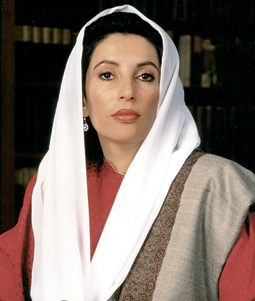 The news is ablaze; the blogs are on fire; Rawalpindi and Sind are burning. Former Pakistani Prime Minister, Benazir Bhutto, was assassinated today at a political rally in Rawalpindi, Pakistan.
The news is ablaze; the blogs are on fire; Rawalpindi and Sind are burning. Former Pakistani Prime Minister, Benazir Bhutto, was assassinated today at a political rally in Rawalpindi, Pakistan.
While few Sikhs will shed any tears for Bhutto as she was personally responsible for the deaths of many Sikhs during the 1980s, the current crisis of the neighboring state cannot be ignored.
The ramifications for the global ‘war on terror’ are yet unknown. In Pakistani circles, most believed that a Washington-brokered power-sharing agreement had been reached between General Musharraf and Bhutto. Despite the General’s declaration of ‘martial law,’ Bhutto’s criticisms had been muted. However her outcry became shriller as opposition within her political party called for her stronger support towards its beleaguered party members, who were coming under arrest and greater security scrutiny. In recent times the relationship (at least in the media) has soured.
The ramifications for Pakistani democracy may be severe. Many are speculating that Musharraf will use this event to postpone (perhaps indefinitely) the upcoming elections and further trample on any that oppose him.
Does this sound familiar? It sounds like it could be many areas in India, including Punjab…

The preference for boys here is centuries old and was rooted in part in an agrarian society that relied on sons to do the hard work on family farms…[A son’s]… elevated status came with certain perquisites — men received their families’ inheritance — but also responsibilities. Once the eldest son married, he and his wife went to live with his family; he was expected to support his parents financially while his wife was expected to care for them in their old age.
This sounds familiar too:
“In the old days, when there was no adequate social safety net, parents regarded having a son as kind of making an investment for old age security,” … It was common for married men to feel ashamed if they had no sons. Some went so far as to divorce wives who did not bear boys.
This NY Times article isn’t talking about India, …. it’s talking about South Korea, where an interesting reversal is taking place.
In South Korea, once one of Asia’s most rigidly patriarchal societies, a centuries-old preference for baby boys is fast receding. And that has led to what seems to be a decrease in the number of abortions performed after ultrasounds that reveal the sex of a fetus.
Hmm… a reversal of son preference? How did that come about?
The most important factor in changing attitudes toward girls was the radical shift in the country’s economy that opened the doors to women in the work force as never before and dismantled long-held traditions, which so devalued daughters that mothers would often apologize for giving birth to a girl.
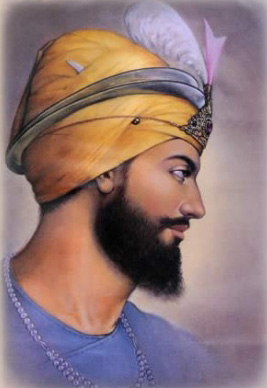 This time of the year always makes me wonder how children in our community perceive Christmas. As a child I don’t remember having a Christmas tree in my house or any talk about Santa Claus coming with gifts (maybe my parents wanted to “keep it real” for me!). However, now that I have a niece and nephew, I do wonder how to create a sense of celebration for them so they don’t feel isolated from their non-Sikh friends. New Year’s day has always held more significance for me, and our family tradition is starting the year with a sense of peace and renewal by attending the Gurdwara.
This time of the year always makes me wonder how children in our community perceive Christmas. As a child I don’t remember having a Christmas tree in my house or any talk about Santa Claus coming with gifts (maybe my parents wanted to “keep it real” for me!). However, now that I have a niece and nephew, I do wonder how to create a sense of celebration for them so they don’t feel isolated from their non-Sikh friends. New Year’s day has always held more significance for me, and our family tradition is starting the year with a sense of peace and renewal by attending the Gurdwara.
Family friends of ours in Toronto have been creating a Sikh celebration, in a sense, for their children on Christmas day. The children put ornaments on their Khalsa Tree, and wait for Santa Singh to bring their gifts. (I am also pretty sure ladoos are awaiting him as an alternative to cookies!). They don’t celebrate the birth of Christ, but instead the birth of our tenth guru, Guru Gobind Singh Ji. When I first heard about their tradition I was impressed that someone had thought to substitute every part of the day in order to teach their children our traditions, and at the same time do the things that go along with the commercialistic nature of the holiday.
Often I find myself teaching many of my non-Sikh friends about the special days we have in our religion throughout the year. They really enjoy learning about my religion and I feel it’s important especially since they would not normally have the opportunity to be educated about Sikhs and what we stand for. One friend once commented how lucky I was to have so many days to celebrate. He was absolutely right – we really are blessed to have the opportunity to celebrate our strong history throughout the year. If as a community we can begin to incorporate the importance of our history and these days into the next generation, we can truly preserve an essence of what Sikhi has to offer.
As I have been thinking about the Sikh community’s mobilization against post-9/11
I feel as though the discourse on Sikhs being the targets of racial profiling has really been about keshdari Sikhs. I must preface this argument with the statement that I understand the issues that khesdari Sikh men face every day are quite different than those of clean-shaven Sikhs. The experience of physically looking quite different than the majority of the clean-shaven population, regardless if it’s brown, white, yellow, or pink, that surrounds you does not make it “easy” to blend in. I sympathize and, more importantly, respect and admire your actions to keep your khes (i.e. hair) as a symbol of your Sikh identity. Furthermore, I undoubtedly agree that keshdari Sikhs have been the targets of racial profiling and victims of hate crimes following the events of 9/11 because “they look like Osama Bin Landen” and “all the other bad guys in
I have heard of a few cases of clean-shaven Punjabi Sikh men being racially profiled and harassed as our Arab and Muslim brothers … I would not doubt it happening to Latino men too. I remember one clean-shaven Punjabi Sikh gentlemen sharing his experience with racial profiling immediately following the 9/11 attacks in the film, “Divided We Fall: Americans In The Aftermath”. These stories made me wonder if Sikh organizations, such as the Sikh Coalition and SALDEF, have made a concerted effort to reach out to clean-shaven Punjabi Sikh men to document and represent their experiences in petitions and memos sent to policy makers and politicians about Sikh racial profiling. Or are these men not Sikh “enough” to be part of the discussion? Some could argue that it is the external representation of Sikh identity that is being targeted for racial profiling, such as the turban and beard; clean-shaven Sikh men don’t display either of those markers. However, I would argue, aren’t the majority of khesdari Sikh men being targeted because they are also “brown”? They are the ones I have commonly seen being represented in films, commercials, and literature on the fight against Sikh racial profiling. Hence, isn’t there a shared history of discrimination and profiling based on “dark” features” along with a common religious belief system, regardless of the varied decisions made by Punjabi Sikh men on keeping their hair?
So Modi and the BJP win again. Kill 2,000 Muslims and become Chief Minister. Hardly new. Kill 3,000 Sikhs and become Minister for Overseas Indian Affairs.
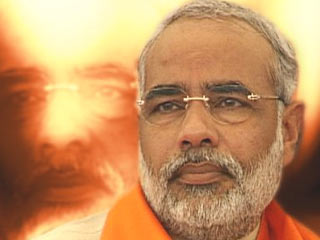 Reasons for Modi’s victory will soon flow: his cult of personality, the use of xenophobic propaganda against “jihadis” (Read: Muslims), the reaction against the anti-Modi media, slogans of development success and Gujarat’s economic boom in the last few years. While the majority in Gujarat will celebrate their victory, I am left wondering.
Reasons for Modi’s victory will soon flow: his cult of personality, the use of xenophobic propaganda against “jihadis” (Read: Muslims), the reaction against the anti-Modi media, slogans of development success and Gujarat’s economic boom in the last few years. While the majority in Gujarat will celebrate their victory, I am left wondering.
Does development trump human rights?
Modi is no longer a Gujarati politician. He is an international Indian star. Nowhere is his popularity as strong as that which he receives from the Patels and NRIs in America. While some assumed the Congress victory in 2004 was a turning point in the electorate, the sheer popularity of Modi’s brand of Hindutva has made him a national level politician. That Sonia Gandhi had to directly intervene to challenge Modi and then to fail will catapult Modi’s stock. He is Hindutva’s celebrity.
The Congress Party’s history and rhetoric offers few opportunities for ambitious political elites. In the new India it is Hindutva that represents the greatest possibility for change. Modi is this change. He is India.
Gurharpal Singh in his Ethnic Conflict in India: A Case-Study of Punjab made this same prediction eight years ago. He saw two possibilities of the Hindutva end game,
either towards a continental assertion of Hindutva or its contraction to the core.
Either the Hindutva agenda will reign supreme or the periphery regions (Kashmir, Punjab, Nagaland, Assam, etc.) that are not Hindu and can mobilize on non-Hindu icons and culture will look for another alternative.
Many of our recent posts have involved discussion about relationships and gender differentiations in our community. So on Thursday, when I drafted this post, I decided to read the “hukamnama” from Darbar Sahib Amritsar and see what Guru Granth Sahib Ji had to say that day.
For those of you who are novice to hukamnamas – a “hukamnama” is a royal edict or decree. In the Sikh context, the hukamnama serves as a command from the Guru, a lesson in the Sikh perspective, and is something to reflect upon for (at least) the day. The hukamnama for that day was as follows:
Sorat(h) Mehalaa 5 Ghar 2 Dhupadhae
Ik oa(n)kaar Sathigur Prasaadh ||
Sagal banasapath mehi baisa(n)thar sagal dhoodhh mehi gheeaa ||
Ooch neech mehi joth samaanee ghatt ghatt maadhho jeeaa ||1||
Sa(n)thahu ghatt ghatt rehiaa samaahiou ||
Pooran poor rehiou sarab mehi jal thhal rameeaa aahiou ||1|| rehaao ||
Gun nidhhaan naanak jas gaavai sathigur bharam chukaaeiou ||
Sarab nivaasee sadhaa alaepaa sabh mehi rehiaa samaaeiou ||2||1||29||Sorat’h, Fifth Mehla, Second House, Du-Paday:
One Universal Creator God. By The Grace Of The True Guru:
Fire is contained in all firewood, and butter is contained in all milk.
God’s Light is contained in the high and the low; the Lord is in the hearts of all beings. ||1||
O Saints, He is pervading and permeating each and every heart.
The Perfect Lord is completely permeating everyone, everywhere; He is diffused in the water and the land. ||1||Pause||
Nanak sings the Praises of the Lord, the treasure of excellence; the True Guru has dispelled his doubt.
The Lord is pervading everywhere, permeating all, and yet, He is unattached from all. ||2||1||29||
Initially, I read the hukamnama for its obvious meaning: the light of the Almighty is in every person. But as I tried to make sense of the hukamnama in relation to the ongoing discussion about relationships, it dawned on me that perhaps the Guru’s message is deeper than just acknowledging the inherent God-light in our fellows. Ultimately, if we see the spark of God in every person with whom we interact, we would treat that individual differently.
I realize presenting this hukamnama is no solution to the problem of gender inequality/differentiation/bias, but I think that a lot of the time we lose sight of the point that our Guru demands that we treat others in a certain manner.
If we were given the change to meet and interact with Akal Purakh on a regular basis – how would we behave? Would we deceive, abuse, or abandon Him? As a Sikh then, how must we treat each other (especially our companions) in light of the above hukamnama?
Earlier this week the Haryana and Punjab high courts struck down a provision in SGPC-run schools that reserves 50% of its seats for Sikhs under the same concept as the federal provision for reserved seats for historic minorities. The SGPC is contesting the ruling, arguing that while Sikhs may constitute a majority of the Punjabi population, Amritdhari Sikhs, for whom seats are reserved, are a very small comparative minority.
This issue made me think of previous conversations I’ve had with friends over whether or not Amritdhari Sikhs, or even just Keshdari Sikhs, are a shrinking minority. Within the diaspora this is certainly the case — the number of Sikhs, particularly second- and third-genners, who choose to take amrit seems to decrease every year. I’ve met many folks who discuss their hesitancy; perhaps we don’t know Punjabi as well in the diaspora, or the lack of training within sangats makes it hard to pass on knowledge. But for many, being an Amritdhari Sikh also vastly limits their relationship choices and options.
As a community, do we see this as a problem? I always find this news disheartening, but I would be lying if I said I would line up to take amrit anytime soon. How does the growing expansion and changes of the demographics of the Sikh community make things easier, or more challenging, when it comes to advocating for issues together? Do different subsections of the population feel more or less lonely/alone in their experiences?
I recently had a conversation with a friend whose relationship with his fiancée is in a bit of turmoil …
Let’s call him Jasdeep and his fiancée- Palwinder. They’ve been dating for a few years, told both parents who gave their consent/supported the relationship and a formal engagement date was set.
They’ve already been through some minor trials and tribulations thus far (long-distance + demanding jobs) but made it through ok. The formal engagement was set to take place late next year but recently I started hearing that the engagement would be delayed, not because of any familial or community pressures, but by a decision made by the couple themselves… From what I’ve seen in the past, a delay means an inevitable cancellation at some point in the future.
From what I know, they both felt that something was amiss in their relationship, a disconnect, though I don’t know what the source of it was. But their reactions to this disconnect are what have left me searching for an answer.
Palwinder is willing to do whatever is necessary to save the relationship. She’s willing to change, to continue long-distance if circumstances demand. Jasdeep, on the other hand, is willing to try only if circumstances make it easy, and hasn’t mentioned any need to change himself in any way.
Now, Jasdeep is normally not an alpha male, demanding his way in every small matter, he is willing to compromise in most circumstances… which is why this catches me off guard.
It could be the case that Palwinder is going through something (whether short term or long term) that’s harmful to her and the relationship, and it would in fact be healthy for both her and the relationship if she worked through it. Maybe she recognizes that and that’s why she’s willing to do so much.
But this reminds me of a pattern I’ve seen often, even if it turns out that this case isn’t an instance of it…
Amongst various sets of parents, cousins, uncles & aunts, friends- when something is amiss and in need of change, in overwhelming instances, it’s the woman who is more than willing to do whatever’s necessary to compromise to try to save the relationship. Maybe this partly stems from the traditional assumption that we’ve grown up with, where the failure of the relationship is considered to be a failure of the woman… (I recognize that such an assumption would be false in many ways, but it’s still out there…)
My question is: Why do women work so hard to compromise when the other half of the equation doesn’t want to budge?
And how, if at all, is this subtle imbalance in relationships linked to the harsher violence against women in Punjabi (maybe all South Asian) communities?
I always get asked about how my spouse and I met; those that are aware of Desis and the “arranged marriage” are always curious as to whether my marriage was in fact arranged. My first thought– how do you define arranged? We were introduced, by mutual acquaintances. The introduction – was under the pretenses of marriage. So essentially our first conversation was: “I want x number of children, and I am x feet tall, and I have the following expectations of a spouse”. I’M KIDDING!
I digress…
Our parents were involved, they spoke before we spoke, but that was the end of their role. Our conversations, and relationship progressed in an organic, albeit SUPER SPEED way. My response to the question is always vague, full of “ums” and quite honestly, it changes every time I am asked the question.
So this past weekend, when a coworker asked me if my marriage was arranged, I gave my usual: “Not really. Um, we were introduced. Our parents were involved. But the decision was ours. etc etc”
Usually I get a smile, and a “oh that’s cool”. This time: “I’m actually pro-arranged marriage”.
SAY WHAT?
You, the very liberal, forward thinking, all things unconventional co-worker – are PRO the arrangement of marriage?!
Disbelief, relief, confusion. A few things I felt.
Our discussion became increasingly interesting at this junction. Let’s call my co-worker “Yogi” – as in one who practices/teaches Yoga, not the bear.
Yogi, having traveled to exotic India, being aware of different cultures (yet extremely American) and has been in a committed relationship for the last 15 years, claimed that love has very little to do with a successful marriage.
BUT THE BEATLES SAID ALL YOU NEED IS LOVE!
According to Yogi (and maybe even BooBoo), it doesn’t matter who one marries, as long as both parties want to be part of an open, communicative and authentic relationship, a marriage will work. Love is a romanticized notion that sets up false expectations.
Um why does Yogi all of a sudden sound like my dad?
We got into a fairly lengthy and personal conversation and it still has me thinking. What is making my marriage work? What will guarantee it will continue to work?
Obviously there are examples of toxic relationships in both the “arranged” and “love” world. But what is the common denominator?
Does this imply that you don’t in fact “need time to get to know the person” before marrying them? Where do values, habits, likes and dislikes come to play? Is it an over-generalization? Easier said than done?
Or does it hold some truth….
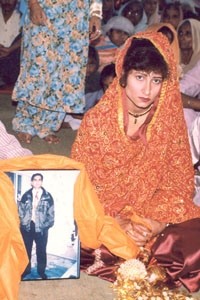 Blimey. Last week National Public Radio picked up a story about one of the newest scams to hit the community, that of Runaway Grooms. If NPR is doing a story about Punjabis and/or Sikhs, you’d hope it would be for something like this instead. So forgive me, if I think it’s disappointing (although maybe not surprising) that instead our community is the focus of an issue that seems to be quite prevalent in the Punjabi community in India and has links to England and North America aswell. Actually, it is very prevalent. Data suggests that 15,000 women in Punjab alone have been victim to men who, after getting married (and after taking the dowry money) return abroad never to be heard from again. Yup, these guys pull a Houdini. Here’s an excerpt from the NPR piece:
Blimey. Last week National Public Radio picked up a story about one of the newest scams to hit the community, that of Runaway Grooms. If NPR is doing a story about Punjabis and/or Sikhs, you’d hope it would be for something like this instead. So forgive me, if I think it’s disappointing (although maybe not surprising) that instead our community is the focus of an issue that seems to be quite prevalent in the Punjabi community in India and has links to England and North America aswell. Actually, it is very prevalent. Data suggests that 15,000 women in Punjab alone have been victim to men who, after getting married (and after taking the dowry money) return abroad never to be heard from again. Yup, these guys pull a Houdini. Here’s an excerpt from the NPR piece:
Satwant Kaur was full of hope and happiness on the day she got married. She had landed a husband who lived and worked overseas in Italy before returning to India to find a bride. She was looking forward to leaving her home in Punjab, northern India, for an exciting new life in Europe. Less than a week after the wedding, it became obvious that her husband, Sarwan Singh, had no intention of taking her with him back to Italy. She was the victim of a scam.
Women in India pay these men a hefty dowry in anticipation of the marriage and the promise to travel with them abroad. However, as it’s becoming increasingly clear, these men have NO intention of bringing their brides overseas and instead extort them of, what often is, their family’s savings. NPR may have picked this story up just recently, but this tale is not new. Ali Kazimi, a filmmaker, made a documentary about this called Runaway Grooms which has screened at various film festivals across the country. It’s a powerful film that leaves you in disbelief that this continues to happen in our community. What impacted me most about this film, however, was the strength that existed within these women who had quite clearly been abandoned. It reminded me of the same strength I see from Punjabi and Sikh women, that I know, who have come through similar tribulations.
At the root of this problem, and many others, is the tradition of daaj or dowry. Is this going away or has it’s form simply changed? I would suggest listening to the NPR piece and watching Runaway Grooms and then thinking about the impact this is having on our community. Our religion does not condone injustice, but more often than not, when those in our community are victims of fraud and lies, we always seem to look the other way…
